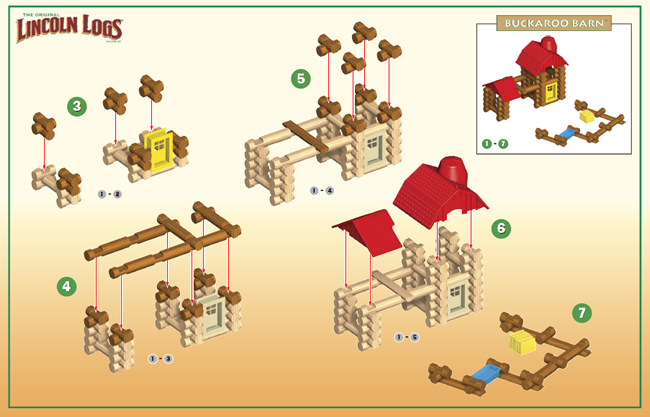Pictorial instructions are part of instructional design, which is related to technical writing. Unlike technical writing, which is based on actual writing with images occasionally used to clarify text, pictorial instructions rely on drawings to communicate information, and occasionally use text to clarify the illustration.
Studies have shown that most humans have a cognitive preference towards picture based instructions – pictures are easier to understand and remember. Unlike reading, which is a skill that is taught researchers assume that humans learn to understand and follow pictorial instructions through experience and exposure. Children are exposed to pictorial instructions at an early age through toys that require assembly and construction, such as Lego and Lincoln logs.

A hybrid of pictorial instructions with text often provides the best combination for clarity.
When it comes to a choice between text-only instructions, pictorial instructions, or a combination of the two, text-only is the often the least-preferred option. A combination of text and pictures is usually required in order to clarify ambiguities. However, well designed pictorial instructions can communicate effectively even without words. And, often where the target audience has low or varying literacy levels, text is omitted entirely.
From the company’s perspective, using pictorial instructions saves on localization costs. Furniture companies, such as Ikea, offer a well-known example of pictorial instructions. However, while pictures are often worth a thousand words, there are plenty of instances where a thousand words are preferred to a single picture. Like poorly written technical manuals, poorly designed pictorial instructions often hinder and confuse users rather than help.
Pictorial Instructions for Children
Pictorial instructions play a very important role in children’s development. Building and model toys, such as Lego® and Lincoln Logs®, help develop instruction comprehension and assembly competency among young children. Children often get their first instructions through toys that expose the child to the problem solving process of building and construction. Pictorial instructions are used to communicate these steps, which develop these skills as well as visual literacy.
As a target audience, children have their own special requirements when it comes to designing pictorial instructions. Children require age appropriate building toys. The age determines the size of parts, number of parts, materials and motor skills required, and also the complexity of the instructions. Six or seven year olds are going to have a more difficult time following instructions than eight or nine year olds. The older the child the better he is able to understand the instructions.

Exposure to pictorial instructions helps children develop visual literacy
Experience also helps children understand pictorial instructions. There are two types of experience familiarity with the toy, and exposure to pictorial instructions. The more children are used to playing with Lego, the better they can follow the instructions, and the more exposed they become to the Lego pictorial instructions, the better they can understand these type of instructions in different contexts, such as Bionicle, or Lincoln logs.
Gender may also be a factor, as some studies have shown differences in the performances of boys and girls. However, many differences can also be explained by previous exposure to building experience, and that there are many more building toys (robots, spaceships, vehicles) designed for boys than for girls.
Pictorial Instructions in Medicine
Pictorial instructions are also useful in medicine. Studies have shown that pictorial aids help people better remember, understand and adhere to medication instructions, especially useful in conveying information about dosages and when to take the medicine. And in addition to improving understanding, pictorial instructions also improve customer satisfaction.
Traditional medication instructions, which are provided as labels on bottles, and leaflets or brochures, display many shortcomings. The small print is difficult to read, and the instructions are written at a fairly advanced reading level, which makes them difficult to comprehend for most consumers. This often leads to patients misunderstanding their medication instructions, such as dosage, timing and frequency, posing significant risks.
Studies indicate that pictorial instructions can be used to effectively convey the pertinent medical information in a way that consumers can easily understand. The figure below illustrates this. The pictorials indicate that one tablet should be taken in the morning and two at night. The medication should not be taken with dairy products or alcoholic beverages. The patient should avoid excessive exposure to the sun, and the medication may cause drowsiness.
However, there is no clear cut case for replacing text-based instructions entirely with pictorial instructions. One study among adults showed that when dosing schedule was presented via text, or via clock icons, patients recalled more of the text information. Because of the crucial importance of properly interpreting medication instructions, text needs to be provided with the illustrations, as seen in the image below. Pictures should supplement the text, not replace it.
Some Best Practice Suggestions for Pictorial Instructions
- Use realistic colors.
- Image should be drawn to scale.
- Maintain a consistent angle throughout the procedure.
- Illustrate the entire object for each step, not just the area where the action occurs.
- Use arrows to depict actions.
- Keep frames the same size and clearly separated.
- Drawings are preferred to photographs.
- Use distinctive line weights for proper depth perception.
- The drawing should show as many important details as possible.
Sources
Schumacher, Peter., “Creating Effective Illustrations for Pictorial Assembly Instructions,” Information Design Journal 15(1), Jogn Benjamins Publishing Company, 2007: 97-108
The Lego Group, Lego Technic 8204 instructions
K’nex Limited Partnership Group, Lincoln Logs Buckaroo Barn Building Instructions
What has been your experience with creating pictorial instructions, or hybrids of pictorial and text instructions? Feel free to post a comment.
